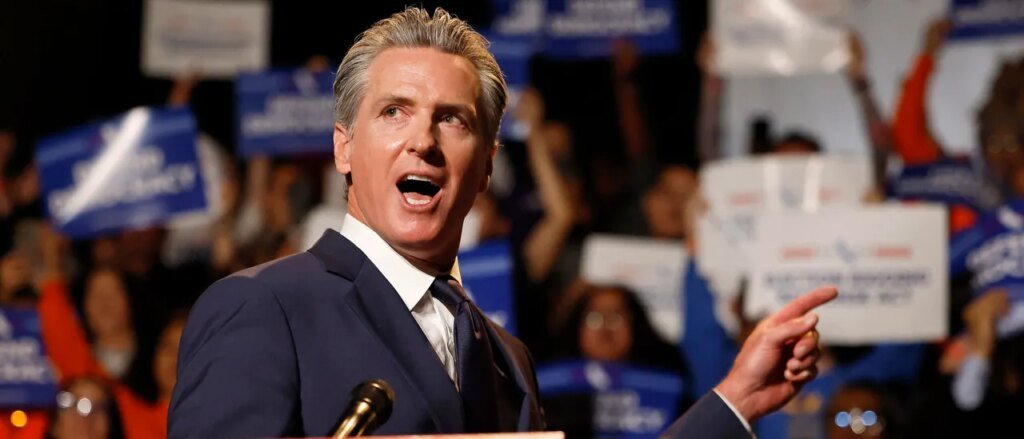California Governor Gavin Newsom has plenty to say regarding environmental policy and the high-speed rail project that the state has funded. However, he often overlooks significant context. In a July podcast episode of Shawn Ryan’s show, Newsom shares insights that are somewhat lacking in depth.
In this final segment of a three-part series, Newsom criticizes Trump and Congressional Republicans for their attempts to slightly reduce green energy subsidies. He states, “We’re increasing average utility costs by cutting green energy tax breaks and pushing out coal and, more notably, oil and gas.”
To put it in perspective, wind energy receives roughly 48 times more in subsidies compared to oil and gas, while solar has around 168 times the financial support.
Now, let’s consider what California has accomplished in terms of electricity prices over the past 20 years. Back in 2005, during my first year in the California Legislature, the state ranked eighth highest in the nation for electricity costs. Fast forward to today, and California holds the second highest rates, just behind Hawaii, despite being touted for its affordable green energy, which often relies on diesel generators alongside some solar input.
In his podcast, Newsom proudly mentions California’s green energy achievements, exclaiming, “We operate the fourth largest economy primarily on green energy for most of this year.” But realistically, for the grid to function year-round, it must be “100% green” consistently, not just part of the time. If we consider times of high costs or outages, such claims feel somewhat empty. It’s worth noting that California’s retail electricity prices are generally 1 to 2 times higher than Texas’s average.
Before that, Newsom highlights a pressing issue related to energy needs, stating, “Take a look at the next-generation AI data center—its energy demand is skyrocketing.” He continues, emphasizing the need to manage battery storage effectively and tackle the inherent challenges of scaling renewable resources. There’s a significant cost to battery storage that, at times, seems beyond what is feasible globally.
In 2008, California voters approved the state’s high-speed rail project. I voted against it and even authored an official discussion about it, believing that the proposed San Francisco rail link was more of a financial burden given affordable commuter flights and highways. It appeared to chiefly benefit contractors and eco-advocates rather than average Californians.
Newsom once echoed this sentiment during his first state address in 2019, where he criticized the program’s mismanagement and high costs, suggesting a need for a scaled-back version. He mentioned, “Halting high-speed rail would waste billions on unfulfilled promises and legal battles.” He then proposed a more limited route through Central Valley, known for its agriculture.
The previous administration quickly halted federal support for the project, citing California’s failure to uphold its commitments after accepting federal funds intended for a larger rail plan from the Bay Area to LA.
Instead of scaling down losses, Newsom persists, seemingly driven by an ego to keep the project alive, leading to further expenditure of taxpayer funds.
During the podcast, Newsom claims progress on the rail effort, stating, “We’ve established the groundwork and constructed 50 structures.” He then contrasts California’s progress with Texas’s struggles with high-speed rail.
What he fails to mention is that Texas’s Houston project is a private initiative that has faced significant legislative roadblocks. The Texas Legislature passed a law in 2017 banning public funding for high-speed rail initiatives, with a federal allocation coming only recently from the Biden administration to further this project.
Initially sold to voters in 2008 at a projected cost of $33 billion, the price tag for California’s high-speed rail project has ballooned to $130 billion, with no clear completion timeline. The anticipated 171-mile segment alone could end up costing $38.5 billion, when earlier estimates were much more modest. The thin projected ridership complicates the feasibility, especially for a line connecting Bakersfield and nearby areas.
In fact, the funding gap for this truncated segment could reach $10.2 billion following substantial cuts to federal funding. Voters were initially reassured that the project would be financed “without raising taxes” and would secure private and federal funds before utilizing state bonds—both claims turned out to be misleading.
Ultimately, if California’s high-speed rail had been managed with less ego and more humility, it might have had a better chance of offering effective service for its taxpayers.







